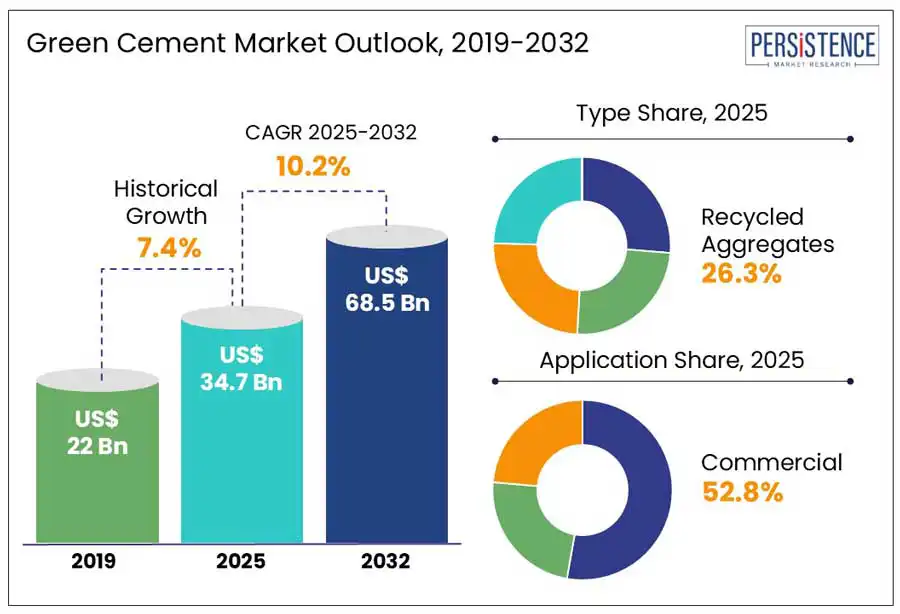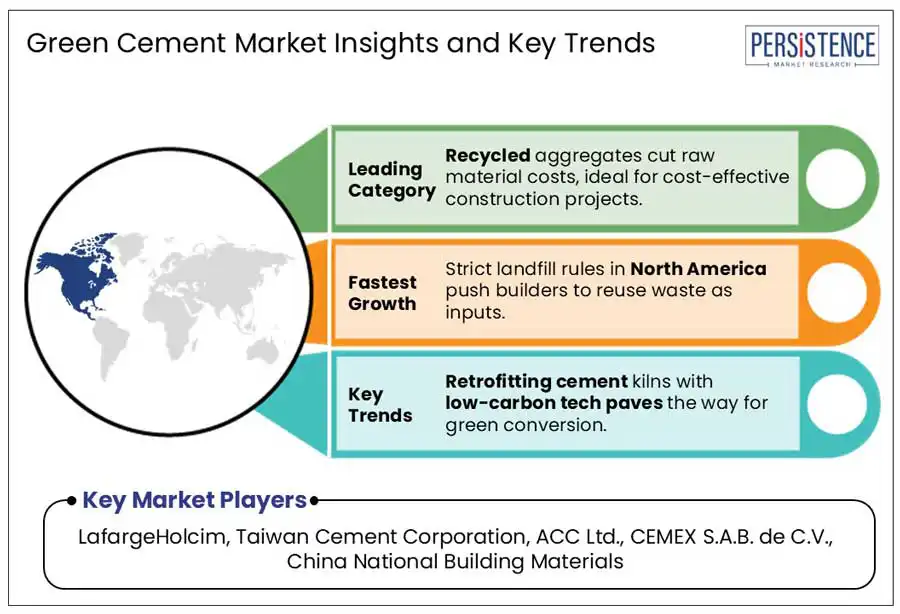Comprehensive Snapshot of Green Cement Market Including Regional and Country Analysis in Brief.
Industry: Chemicals and Materials
Published Date: April-2025
Format: PPT*, PDF, EXCEL
Delivery Timelines: Contact Sales
Number of Pages: 180
Report ID: PMRREP33582
The global green cement market size is projected to rise from US$ 34.7 Bn in 2025 to US$ 68.5 Bn to witness a CAGR of 10.2% by 2032. Green cement, often known as sustainable cement, is usually produced by using eco-friendly methods and materials that require fewer natural resources and energy. Manufacturing companies are likely to receive incentives from government bodies for the development and scaling up of green cement with rising environmental concerns. A few companies use heat waste and biomass from industrial processes to manufacture this type of cement.

Key Industry Highlights
|
Global Market Attribute |
Key Insights |
|
Green Cement Market Size (2025E) |
US$ 34.7 Bn |
|
Market Value Forecast (2032F) |
US$ 68.5 Bn |
|
Projected Growth (CAGR 2025 to 2032) |
10.2% |
|
Historical Market Growth (CAGR 2019 to 2024) |
7.4% |
Green building certifications and regulatory pressure are anticipated to propel the global market by 2032. The European Union’s Fit for 55 package, for example, mandates a 55% trimming in greenhouse gas emissions by 2030. This is envisioned to bolster the construction sector to embrace low-emission alternatives such as green cement.
Green building standards such as Building Research Establishment Environmental Assessment Method (BREEAM) and Leadership in Energy and Environmental Design (LEED) are further estimated to make green cement appealing to builders as these emphasize the use of low-carbon materials. The Perform, Achieve, and Trade (PAT) scheme under the Bureau of Energy Efficiency in India also provides incentives to large-scale industries, including cement, to use low-energy technologies.
Even though green cement has several environmental benefits, it is poised to face certain challenges in the foreseeable future due to limited scalability and high manufacturing costs. The cement is made from industrial byproducts such as slag and fly ash, which are not always available in abundance across certain regions. In the U.S. and Europe, the phasing out of coal-powered power plants is predicted to hamper the availability of fly ash. This scarcity is anticipated to affect the economic viability of green cement and drive costs.
Green cement production technologies are also expensive, thereby limiting growth. The Global Cement and Concrete Association (GCCA) stated in its 2023 study that shift to low-carbon cement is projected to cost the industry nearly US$ 200 Bn worldwide by 2050. Small-scale players specifically those in emerging economies are expected to encounter problems and rely on traditional approach.
The integration of Carbon Capture, Utilization, and Storage (CCUS) technology in green cement manufacturing is poised to create new growth prospects. CCUS technology can help reduce carbon dioxide emissions. This technology also enables cement plants to sell captured carbon for utilization either in the production of synthetic chemicals and fuels or other industrial processes.
Companies such as Heidelberg Cement are spearheading this field with the Brevik CCS project in Norway. It is anticipated to capture about 400,000 tons of carbon dioxide every year starting in 2024. Green cement companies are estimated to capitalize on this trend through the implementation of carbon trading and credit schemes.
A key trend in the market is the increasing localized manufacturing of green cement by using indigenous waste materials. This helps address both logistical and environmental challenges related to traditional cement manufacturing. This approach not only promotes circular economy practices but also reduces carbon footprint by using locally available agricultural and industrial waste that would otherwise lead to landfill congestion or pollution.
Start-ups such as Gjenge Makers in Kenya are constantly investigating cement-like materials made from sand and plastic waste. In Vietnam, researchers found that using 20% rice husk ash in cement blends can enhance resistance to chemical attacks and lead to a 24% reduction in embodied carbon. Similar research and development activities, especially in developing countries, are expected to play a key role.
Based on type, the market is segregated into fly ash, slag, and recycled aggregates. Among these, recycled aggregates are anticipated to hold a green cement market share of nearly 26.3% in 2025, reveals Persistence Market Research. It is attributed to their ability to address two key challenges simultaneously, namely, reducing the carbon footprint of cement manufacturing and lowering construction waste.
As per studies, every year, more than 2.2 Bn tons of Construction and Demolition Waste (CDW) is generated worldwide. Manufacturing companies and builders crush this waste into usable aggregates to significantly lower reliance on virgin materials such as gravel and sand, which are environmentally harmful to extract and increasingly scarce.
Slag is also predicted to exhibit a steady growth rate through 2032 as slag-based cement provides high sulfate resistance, low permeability, and superior durability. This makes it suitable for underground, coastal, and marine constructions.
In terms of application, the market is bifurcated into residential and commercial. The commercial segment will likely dominate with a 52.8% share in 2025. Integration of low-carbon targets into corporate environmental, social, and governance (ESG) frameworks is expected to drive the segment growth.
Corporate campuses globally are using green cement to comply with net-zero building certifications. Key developers such as Mahindra Lifespaces and Godrej Properties in India use fly ash and Ground Granulated Blast Furnace Slag (GGBFS)-based cement to comply with internal ESG goals. Mahindra Lifespaces stated that it has successfully reduced embodied carbon in concrete structures by 15 to 20% with green cement usage.
Residential application, is speculated to surge at a decent pace by 2032, backed by the rise in emphasis on sustainable building practices among policymakers, builders, and homeowners. In Europe, green cement is used in precast residential flooring slabs and wall systems as energy-efficient homes have become a standard in the region.

In 2025, North America is expected to account for a share of about 22.9% in 2025. It is attributed to rising green public procurement, federal decarbonization policies, and increasing focus of investors on sustainable materials. The U.S. green cement market is estimated to remain at the forefront due to increasing federal and state funding, enabling start-ups to accelerate production.
The Inflation Reduction Act of 2022 further allocated around US$ 5.8 Bn toward industrial decarbonization, specifying the development of low-carbon cement technologies. It includes grants for extending low-carbon cement production as well as tax benefits for manufacturers investing in CCUS. The country’s Buy Clean Initiative also mandates the adoption of low embodied carbon-based construction materials, mainly in federal projects.
China, produces around 50% of the world's cement, has exhibite a surge in green cement demand. Under its Dual Carbon goals, the government is striving to achieve carbon neutrality by 2060 and carbon peak before 2030. The Ministry of Industry and Information Technology has also implemented strict norms to reduce carbon emissions from cement production. Hence, it is hence supporting the use of blended cement with industrial by-products.
Vietnam is one of the most prominent exporters of clinker and cement in Asia Pacific. It has adopted green cement to gain a competitive advantage. Companies such as Fico-YTL and Vicem have already started mixing cement with slag and fly ash to reduce emissions by 30% to 40%, specifically in infrastructure projects located in the coastal areas.
Europe is envisioned to be spearheaded by France as it has implemented several stringent environmental norms such as the RE2020 building code. The code has mandated companies in the country to reduce embodied carbon in construction, thereby boosting demand for green cement. LafargeHolcim France, for instance, recently introduced ECOPlanet, its latest low-carbon brand, promising up to 50% lower emissions.
Norway and Sweden, on the other hand use green cement due to the implementation of net-zero targets. Cementa, based in Sweden is currently developing fossil-free cement by using renewable energy. It has already bagged government approval for the construction of a carbon storage facility under the Baltic Sea. Norway is witnessing a surge in low-carbon material use as public procurement norms are mandate to pursue in national infrastructure objectives.
The global green cement market is highly competitive with the presence of various large and medium-sized companies. They are striving to launch new cement formulations to reduce emissions and comply with sustainability standards. A few companies aim to set up their production facilities in emerging markets to introduce cost-effective yet superior products for local customers.
|
Report Attribute |
Details |
|
Historical Data/Actuals |
2019 - 2024 |
|
Forecast Period |
2025 - 2032 |
|
Market Analysis Units |
Value: US$ Bn/Mn, Volume: As Applicable |
|
Geographical Coverage |
|
|
Segmental Coverage |
|
|
Competitive Analysis |
|
|
Report Highlights |
|
|
Customization and Pricing |
Available upon request |
By Type
By Application
By Region
To know more about delivery timeline for this report Contact Sales

The global market for green cement is anticipated to thrive at a CAGR of 10.2% during the projected period, 2023 - 2030.
The green cement market currently around US$28.6 Bn.
As of 2023, Germany holds the largest market share in terms of revenue.
Some of the prominent players in the market are LafargeHolcim, Taiwan Cement Corporation, ACC Ltd., and CEMEX S.A.B. de C.V.
Residential sector is the largest market segment set for the fastest CAGR during the forecast period.